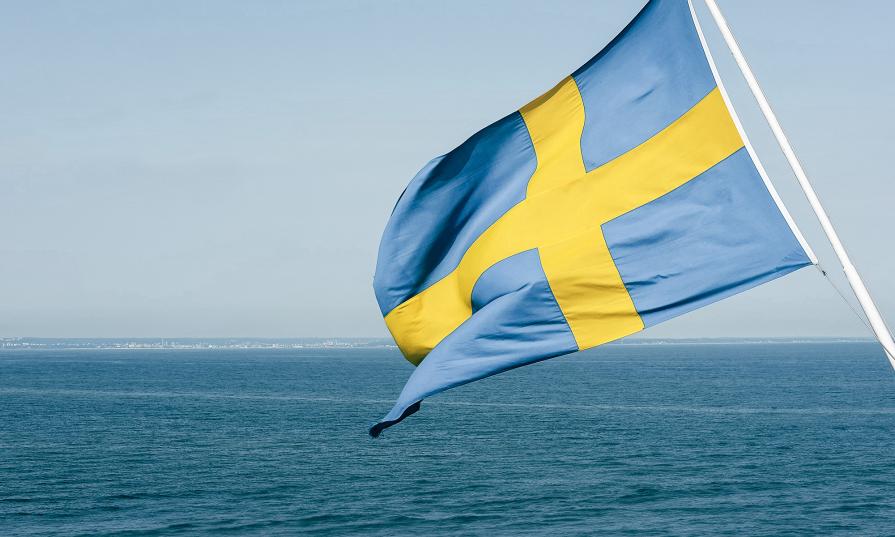The Swedish flag belongs to one of the oldest in Europe: its roots date back to the XV century, and some legends erect its history as far as the XII. In our material, we will present it - and tell a few interesting details that are not known to the general public outside the kingdom of the three crowns.

Early Middle Ages
According to legend, Saint Eric, the legendary ruler of Sweden, saw the golden cross in the sky during his first conquest in neighboring Finland in 1157. This sign and the successful conquest of the poor Finns so impressed him that he made it his flag.
There is no documentary evidence - the first evidence dates back to the middle of the XVI century. It is probably a Swedish adaptation of the legend of Constantine the Great and his victory at the Battle of Ponce Mulvia.
Swedish historian Objerg argues that this flag first appeared as a symbol of resistance to the Danish Union: on the Swedish cross, the colors used by the Danes since 1219 were changed. The next was Karl Knutson - he became the author of a large state emblem, which appeared in 1448 and combined the coat of arms of the authorship of Albrecht Mecklenburg in 1365 and the royal coat of arms of the ruling dynasty.
Another historian, Liljenberg, said that Eric XIV borrowed blue and yellow from the people of Riga, because Riga, which was at that time the Swedish crown rule, was perhaps the most important city in the economic system of the kingdom. And the first reliably existing image of a blue cloth with a yellow cross as a state symbolism is dated 1550 - this is the coat of arms of the province of Southern Finland: 10 years later, a coat of arms of the province of Gotland was placed on the hearse of King Gustav Vasa.

Great Power
As Sweden's influence grew and the scale of its shipping grew, the need for distinctive signs grew – merchant ships began to use a special trade flag, at a great distance showing where the ship was located and to whom it belonged. It received the nickname "chest" or "suitcase" and was a flag with two braids.
In the XVII century, the same began to be used in the navy, and for the difference added another "language". However, there was no uniformity yet, and sailors used both a flag with three or two tails and a rectangle with a cross.
Only by royal decree of November 1663 civil and military flags were divided into spheres of application. Civilians were forbidden to use the crown flag with three braids, instead relying on a flag with a cross without cuts. Any other colored flags were allowed, which was to allow for the attribution of the city and province to which the ship or ship belonged.
The rules were often updated, which gives reason to suspect that they were often violated.
The next major reform of the flag dates back to 1730 – the civil and commercial flag received the appearance of a military royal, but with the tips of the tongues cut off. After 30 years, a special flag was installed for the army - blue with three yellow dots, the same was used for the galley fleet subordinate to the ground forces. Military squadrons until 1813 went under the former cross with braids.
New United State
On March 7, 1815, Norway passed from the subordination of Denmark to Sweden, forming a single monarchy. The country received a single military flag, exactly similar to the Swedish one - but in the upper left corner there was a red corner with an oblique St. Andrew's cross of white color.
At the beginning of the Union era, the Norwegians used the old Danish flag for trade with the addition of a coat of arms at the kryzh. A royal decree of 1821 defined the only flag under which long-distance navigation beyond Cape Finisterre could be carried out - those ships that used other colors could only use them for coastal navigation. And the lucky ones who raised the single flag enjoyed the protection of the Royal Navy and the help of the US consular offices.

Merchant ships could sail under this common flag or use national - Swedish blue-yellow or specially created for Norway.
This state of affairs lasted until 1844, when another Swedish decree granted each kingdom in the union special military banners and commercial flags formed by the colors of both states, symmetrically combined in a single symbol with different order of colors. Such a flag very soon received the joking nickname "herring salad" and served the Norwegians until 1899, and the Swedes until 1905 - until the complete dissolution of the union.
Time to break up
Even 6 years before the collapse of the union, the Norwegians decided to remove all its symbols from the state and commercial flags - so the Norwegian national flag appeared. The Swedes had a similar symbol until 1905, but soon it was replaced by a new one - blue, with a yellow cross, similar to today's. On November 1, 1905, it was erected on state buildings in Karlskrona, Stockholm and other cities, as well as ships of the fleet.
The following year, the blue color lost its saturation and became light blue. And even earlier, in 1897, the law regulated the rules of navigation under the flag, its use in dozens of different cases: from lifting on buildings and institutions to the rules of use in barracks institutions, army training grounds and other cases related to the needs of the state.
Any illegal use of an official banner with three languages or with additional symbols, as well as the sale of a flag that does not comply with the requirements of the legislation, was punishable by a fine of up to a hundred Swedish kronor in silver. However, traditional and familiar flags were allowed to be hung for another two years - after which to get rid of them in a special way that does not allow mockery, shameful actions or burning.













